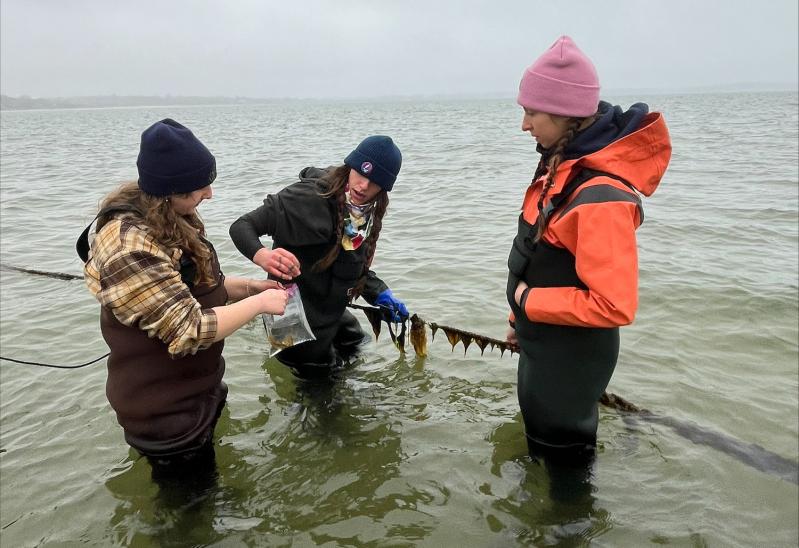Back in January, the East Hampton Town Trustees approved a request from Christopher Gobler of Stony Brook University's School of Marine and Atmospheric Sciences, to grow sugar kelp at Barcelona Point, at the southern end of Northwest Harbor. As part of the Peconic East Blue Carbon Shoreline Protection Project, funded by the Peconic Estuary Program, it is focused on acidification reduction, nitrogen bio-extraction, guarding shorelines, ecosystem longevity, and sequestration of carbon.
Kelp, a most humble, elongated form of seaweed, is one of the fastest growing plants in the world. Wild strands of kelp on the East End can grow up to six feet long. More significantly, kelp takes in five times more carbon than most plants on land, and sequesters more carbon than eelgrass, mangroves, and salt marshes combined based on biomass, countering the acidification of the oceans resulting from their absorption of carbon dioxide from greenhouse gas emissions.
In local waters there has been a decrease of kelp, much of which was typically found from the east side of Gardiner's Island all the way to Montauk and beyond. But Dr. Gobler and a trio of his marine researchers have begun to grow and analyze sugar kelp in shallow water. He noted that the pilot program was successful in the Great South Bay, where in many areas it is growing in barely 10 feet of water.
While summer is nearly here, I still vividly recall a cold and dreary morning three months ago. The water was about 42 degrees off Barcelona Neck at around 7 as I entered it with a troika of marine researchers from Stony Brook University. The northeast breeze and fog bank that stuck stubbornly in the place made it feel even colder.
What made it considerably worse was that my newly acquired hip waders, which cost over $150, began to leak almost immediately. My legs became instantly frozen. When I returned home, the waders went into the dumpster.
The intense young researchers I shared that morning with are also known by many here as the Kelp Heads.
"They are so really into it," said Rick Pickering, who, with his son, Adrian, runs Ship Ashore Marina in Sag Harbor, where I also dock my Rock Water. Pickering allowed the Kelp Heads to string out several ropes to grow their crop for further examination and analysis a few scant yards from my boat. The Kelp Heads also tended to several other test sites on North Haven, Shelter Island, and Southampton. "It's great to see their passion."
"We are seeing some good results in many of our test locations," said Margot Eckstein, a research support specialist, as she gently removed small strands of kelp from the rope into a plastic bag that winter morning, as my waders began to fill up with water. "It's been a really cool project to work on."
The kelp project concluded in May but will resume again in the late fall. Unbeknownst to me, kelp only grows when the waters are cold. Who knew? I'm glad there are good people involved to help with kelp.
Turning to those with a rod and reel in hand, the striped bass bite in many areas continues to be hot and heavy. The key word is heavy, as more larger fish up to over 35 pounds have shown up of late. "The bass fishing is literally off the hook," confirmed Capt. Savio Mizzi of Fishooker Charters out of Montauk.
Large bluefish have arrived too, including one that Kat Rollin landed on Friday on a light tackle charter with Capt. David Blinken of North Flats Guiding. The mega blue measured 39 inches (99 centimeters). The world record is 88 centimeters. The fish was gently released and will only get bigger.
At Mrs. Sam's Bait and Tackle in East Hampton, Sebastian Gorgone said that bluefish continue to be taken off Gerard Drive. "Even better, the fluke fishing has picked up nicely. He said that the waters off Accabonac and toward the entrance to Three Mile Harbor have been the hotspots of late. He added that porgies remain plentiful, but that blowfish have been in short supply.
Back at the Montauk Anglers Club on East Lake Drive, the owner, Capt. Will Cornacchia, agreed that the striped bass fishing remains solid, with fish up to 35 pounds landed and released. "There are still a good number of slot-sized fish taken too," he said.
As for fluke, Cornacchia observed that "not a ton of fluke are coming back to the dock, but it's slowly getting better. Guys who are fishing out at Cartwright are catching a few, but they are also landing a lot of codfish too. Unfortunately, the season for them is closed." He added that bluefin tuna have been landed at Atlantis Canyon to the east.
Want to hand-feed some striped bass? Cornacchia said that he and Chris Albronda, who also works at the club, decided to see what would happen if they threw some spearing into the water off their dock a few weeks ago. The response from striped bass was immediate.
"We've been now feeding about eight or more striped bass three times a day," he smiled. "The kids love to feed them and are having a blast. It has really caught on with so many people. It reminds me of those YouTube videos of people hand-feeding large tarpon down in Florida. It's very cool."
—
Fishing tips, observations, and photographs can be sent to [email protected].

